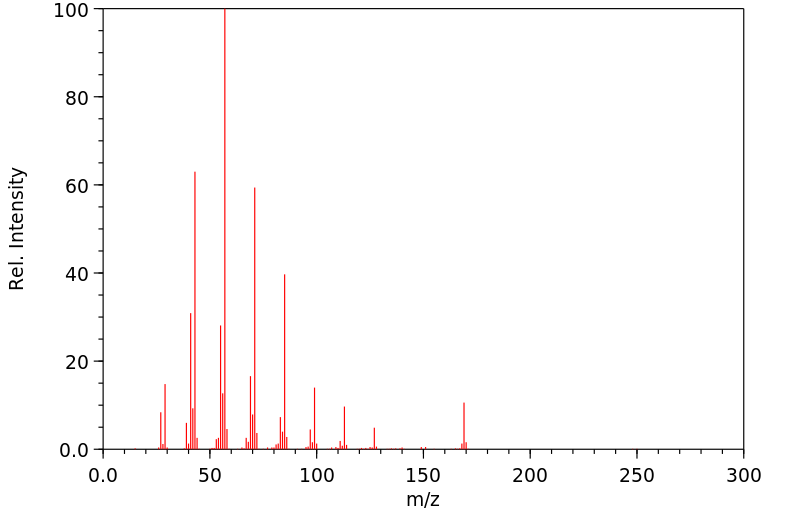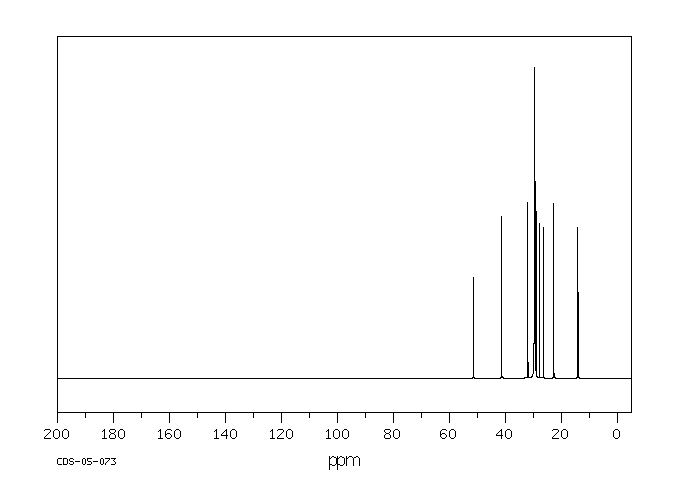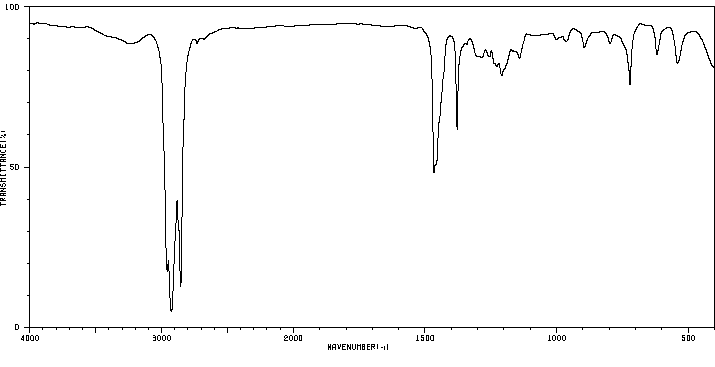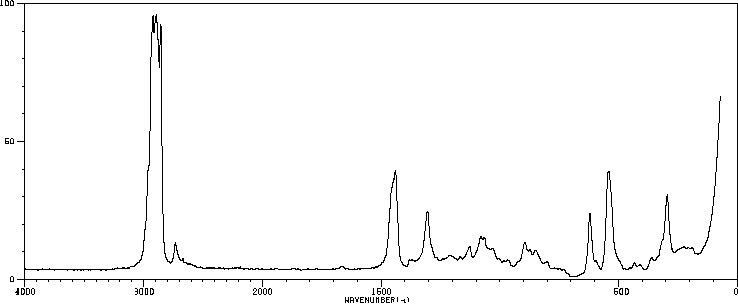2-溴十二烷 | 13187-99-0
中文名称
2-溴十二烷
中文别名
——
英文名称
2-bromododecane
英文别名
——
CAS
13187-99-0
化学式
C12H25Br
mdl
——
分子量
249.234
InChiKey
GIUUCQVKMWBSRT-UHFFFAOYSA-N
BEILSTEIN
——
EINECS
——
-
物化性质
-
计算性质
-
ADMET
-
安全信息
-
SDS
-
制备方法与用途
-
上下游信息
-
文献信息
-
表征谱图
-
同类化合物
-
相关功能分类
-
相关结构分类
物化性质
-
熔点:-96 °C (lit.)
-
沸点:130 °C/6 mmHg (lit.)
-
密度:1.02 g/mL at 25 °C (lit.)
-
闪点:>230 °F
-
保留指数:1505
计算性质
-
辛醇/水分配系数(LogP):6.5
-
重原子数:13
-
可旋转键数:9
-
环数:0.0
-
sp3杂化的碳原子比例:1.0
-
拓扑面积:0
-
氢给体数:0
-
氢受体数:0
安全信息
-
危险品标志:Xi
-
安全说明:S26,S37/39
-
危险类别码:R36/37/38
-
海关编码:2903399090
-
WGK Germany:3
SDS
Section 1. IDENTIFICATION OF THE SUBSTANCE/MIXTURE
Product identifiers
Product name : 2-Bromododecane
CAS-No. : 13187-99-0
Section 2. HAZARDS IDENTIFICATION
Classification of the substance or mixture
Classification according to Regulation (EC) No 1272/2008 [EU-GHS/CLP]
Skin irritation (Category 2)
Eye irritation (Category 2)
Specific target organ toxicity - single exposure (Category 3)
Classification according to EU Directives 67/548/EEC or 1999/45/EC
Irritating to eyes, respiratory system and skin.
Label elements
Labelling according Regulation (EC) No 1272/2008 [CLP]
Pictogram
Signal word Warning
Hazard statement(s)
Causes skin irritation.
Causes serious eye irritation.
May cause respiratory irritation.
Precautionary statement(s)
Avoid breathing dust/ fume/ gas/ mist/ vapours/ spray.
P305 + P351 + P338 IF IN EYES: Rinse cautiously with water for several minutes. Remove
contact lenses, if present and easy to do. Continue rinsing.
Supplemental Hazard none
Statements
According to European Directive 67/548/EEC as amended.
Hazard symbol(s)
R-phrase(s)
R36/37/38 Irritating to eyes, respiratory system and skin.
S-phrase(s)
S26 In case of contact with eyes, rinse immediately with plenty of water and
seek medical advice.
S37/39 Wear suitable gloves and eye/face protection.
Other hazards - none
Section 3. COMPOSITION/INFORMATION ON INGREDIENTS
Substances
Formula : C12H25Br
Molecular Weight : 249,23 g/mol
Component Concentration
2-Bromododecane
CAS-No. 13187-99-0 -
EC-No. 236-142-7
Section 4. FIRST AID MEASURES
Description of first aid measures
General advice
Consult a physician. Show this safety data sheet to the doctor in attendance.
If inhaled
If breathed in, move person into fresh air. If not breathing, give artificial respiration. Consult a physician.
In case of skin contact
Wash off with soap and plenty of water. Consult a physician.
In case of eye contact
Rinse thoroughly with plenty of water for at least 15 minutes and consult a physician.
If swallowed
Never give anything by mouth to an unconscious person. Rinse mouth with water. Consult a physician.
Most important symptoms and effects, both acute and delayed
To the best of our knowledge, the chemical, physical, and toxicological properties have not been
thoroughly investigated.
Indication of any immediate medical attention and special treatment needed
no data available
Section 5. FIREFIGHTING MEASURES
Extinguishing media
Suitable extinguishing media
Use water spray, alcohol-resistant foam, dry chemical or carbon dioxide.
Special hazards arising from the substance or mixture
Carbon oxides, Hydrogen bromide gas
Advice for firefighters
Wear self contained breathing apparatus for fire fighting if necessary.
Further information
no data available
Section 6. ACCIDENTAL RELEASE MEASURES
Personal precautions, protective equipment and emergency procedures
Use personal protective equipment. Avoid breathing vapors, mist or gas. Ensure adequate ventilation.
Evacuate personnel to safe areas.
Environmental precautions
Do not let product enter drains.
Methods and materials for containment and cleaning up
Soak up with inert absorbent material and dispose of as hazardous waste. Keep in suitable, closed
containers for disposal.
Reference to other sections
For disposal see section 13.
Section 7. HANDLING AND STORAGE
Precautions for safe handling
Avoid contact with skin and eyes. Avoid inhalation of vapour or mist.
Normal measures for preventive fire protection.
Conditions for safe storage, including any incompatibilities
Store in cool place. Keep container tightly closed in a dry and well-ventilated place. Containers which are
opened must be carefully resealed and kept upright to prevent leakage.
Specific end uses
no data available
Section 8. EXPOSURE CONTROLS/PERSONAL PROTECTION
Control parameters
Components with workplace control parameters
Exposure controls
Appropriate engineering controls
Handle in accordance with good industrial hygiene and safety practice. Wash hands before breaks and
at the end of workday.
Personal protective equipment
Eye/face protection
Safety glasses with side-shields conforming to EN166 Use equipment for eye protection tested
and approved under appropriate government standards such as NIOSH (US) or EN 166(EU).
Skin protection
Handle with gloves. Gloves must be inspected prior to use. Use proper glove removal technique
(without touching glove's outer surface) to avoid skin contact with this product. Dispose of
contaminated gloves after use in accordance with applicable laws and good laboratory practices.
Wash and dry hands.
The selected protective gloves have to satisfy the specifications of EU Directive 89/686/EEC and
the standard EN 374 derived from it.
Body Protection
impervious clothing, The type of protective equipment must be selected according to the
concentration and amount of the dangerous substance at the specific workplace.
Respiratory protection
Where risk assessment shows air-purifying respirators are appropriate use a full-face respirator
with multi-purpose combination (US) or type ABEK (EN 14387) respirator cartridges as a backup
to engineering controls. If the respirator is the sole means of protection, use a full-face supplied air
respirator. Use respirators and components tested and approved under appropriate government
standards such as NIOSH (US) or CEN (EU).
Section 9. PHYSICAL AND CHEMICAL PROPERTIES
Information on basic physical and chemical properties
a) Appearance Form: liquid
Colour: colourless
b) Odour no data available
c) Odour Threshold no data available
d) pH no data available
e) Melting point/freezing Melting point/range: -96 °C - lit.
point
f) Initial boiling point and 130 °C at 8 hPa - lit.
boiling range
g) Flash point 113 °C - closed cup
h) Evaporation rate no data available
i) Flammability (solid, gas) no data available
j) Upper/lower no data available
flammability or
explosive limits
k) Vapour pressure 19,989 hPa at 20 °C
46,871 hPa at 55 °C
l) Vapour density no data available
m) Relative density 1,02 g/cm3 at 25 °C
n) Water solubility no data available
o) Partition coefficient: n- no data available
octanol/water
p) Autoignition no data available
temperature
q) Decomposition no data available
temperature
r) Viscosity no data available
s) Explosive properties no data available
t) Oxidizing properties no data available
Other safety information
no data available
Section 10. STABILITY AND REACTIVITY
Reactivity
no data available
Chemical stability
no data available
Possibility of hazardous reactions
no data available
Conditions to avoid
no data available
Incompatible materials
Strong oxidizing agents, Strong bases
Hazardous decomposition products
Other decomposition products - no data available
Section 11. TOXICOLOGICAL INFORMATION
Information on toxicological effects
Acute toxicity
no data available
Skin corrosion/irritation
no data available
Serious eye damage/eye irritation
no data available
Respiratory or skin sensitization
no data available
Germ cell mutagenicity
no data available
Carcinogenicity
IARC: No component of this product present at levels greater than or equal to 0.1% is identified as
probable, possible or confirmed human carcinogen by IARC.
Reproductive toxicity
no data available
Specific target organ toxicity - single exposure
Inhalation - May cause respiratory irritation.
Specific target organ toxicity - repeated exposure
no data available
Aspiration hazard
no data available
Potential health effects
Inhalation May be harmful if inhaled. Causes respiratory tract irritation.
Ingestion May be harmful if swallowed.
Skin May be harmful if absorbed through skin. Causes skin irritation.
Eyes Causes serious eye irritation.
Signs and Symptoms of Exposure
To the best of our knowledge, the chemical, physical, and toxicological properties have not been
thoroughly investigated.
Additional Information
RTECS: Not available
Section 12. ECOLOGICAL INFORMATION
Toxicity
no data available
Persistence and degradability
no data available
Bioaccumulative potential
no data available
Mobility in soil
no data available
Results of PBT and vPvB assessment
no data available
Other adverse effects
no data available
Section 13. DISPOSAL CONSIDERATIONS
Waste treatment methods
Product
Offer surplus and non-recyclable solutions to a licensed disposal company. Contact a licensed
professional waste disposal service to dispose of this material.
Contaminated packaging
Dispose of as unused product.
Section 14. TRANSPORT INFORMATION
UN number
ADR/RID: - IMDG: - IATA: -
UN proper shipping name
ADR/RID: Not dangerous goods
IMDG: Not dangerous goods
IATA: Not dangerous goods
Transport hazard class(es)
ADR/RID: - IMDG: - IATA: -
Packaging group
ADR/RID: - IMDG: - IATA: -
Environmental hazards
ADR/RID: no IMDG Marine pollutant: no IATA: no
Special precautions for user
no data available
Section 15. REGULATORY INFORMATION
This safety datasheet complies with the requirements of Regulation (EC) No. 1907/2006.
Safety, health and environmental regulations/legislation specific for the substance or mixture
no data available
Chemical Safety Assessment
SECTION 16 - ADDITIONAL INFORMATION
N/A
反应信息
-
作为反应物:描述:参考文献:名称:用 Tri-2-furylgermane 还原有机卤化物:化学计量和催化还原摘要:Tri-2-furylgermane 被证明是一种有效的有机卤化物自由基还原试剂。在催化量的三乙基硼烷存在下,在 25°C 下,在 THF 中用三-2-呋喃基锗烷处理 1-溴十二烷,几乎可以定量地得到十二烷。在相同的反应条件下,2-碘乙醛烯丙缩醛的自由基环化得到五元产物。这些反应在催化量的氢化锗存在下用 NaBH4 进行。该反应在水中以及在 THF 中进行,以良好的收率得到相应的还原化合物。DOI:10.1246/bcsj.74.747
-
作为产物:描述:1-十二烯十二碳烯α-十二碳烯α-十二碳烯 在 polystyrylmethylenehexadecyldibutylphosphonium bromide 氢溴酸 作用下, 反应 8.0h, 以89%的产率得到2-溴十二烷参考文献:名称:Khurana, Jitender M.; Tetenyi, Peter; Kodomari, Mitsuo, Indian Journal of Chemistry - Section B Organic and Medicinal Chemistry, 1988, vol. 27, # 1-12, p. 1129 - 1130摘要:DOI:
文献信息
-
Triethylborane-Induced Radical Reactions with Gallium Hydride Reagent HGaCl<sub>2</sub>作者:Satoshi Mikami、Kazuya Fujita、Tomoaki Nakamura、Hideki Yorimitsu、Hiroshi Shinokubo、Seijiro Matsubara、Koichiro OshimaDOI:10.1021/ol015904j日期:2001.6.1gallium hydride reagent, HGaCl2, was found to act as a radical mediator, like tributyltin hydride. Treatment of alkyl halides with the gallium hydride reagent, generated from gallium trichloride and sodium bis(2-methoxyethoxy)aluminum hydride, provided the corresponding reduced products in excellent yields. Radical cyclization of halo acetals was also successful with not only the stoichiometric gallium
-
Potential antiatherosclerotic agents. 4. [(Functionalized-alkyl)amino]benzoic acid analogs of cetaben作者:Vern G. DeVries、Elwood E. Largis、Thomas G. Miner、Robert G. Shepherd、Janis UpeslacisDOI:10.1021/jm00364a011日期:1983.10the alkyl group of cetaben is substituted with various functional groups or replaced entirely by a functionalized alkanoyl moiety is described. Also reported are the syntheses of branched-chain (alkylamino)benzoic acids in which branching is specifically localized at the terminus of the alkyl chain. Structure-activity relationships of these compounds, both as hypolipidemic agents and as inhibitors of
-
Electron transfer-induced reduction of organic halides with amines作者:Takahide Fukuyama、Yuki Fujita、Hayato Miyoshi、Ilhyong Ryu、Shih-Chieh Kao、Yen-Ku WuDOI:10.1039/c8cc02445f日期:——Reduction of a variety of organo halides was examined by using amines as a sacrificial hydrogen source. UV light-induced reduction of vinyl and aryl halides with triethylamine proceeded smoothly to give the corresponding reduced products. High temperature heating also caused the reduction and DABCO (1,4-diazabicyclo[2.2.2]octane) also served as a good reducing reagent.通过使用胺作为牺牲氢源,研究了各种有机卤化物的还原。UV光诱导的三乙胺对乙烯基卤化物和芳基卤化物的还原反应顺利进行,得到了相应的还原产物。高温加热也引起了还原,DABCO(1,4-二氮杂双环[2.2.2]辛烷)也用作良好的还原剂。
-
Radical Reaction by a Combination of Phosphinic Acid and a Base in Aqueous Media作者:Hideki Yorimitsu、Hiroshi Shinokubo、Koichiro OshimaDOI:10.1246/bcsj.74.225日期:2001.2Treatment of various organic halides with phosphinic acid (hypophosphorous acid) in aqueous ethanol in the presence of a radical initiator and a base gave the corresponding reduced products in high yields. Addition of a base is indispensable for the reduction of halides by phosphinic acid. Allylic ether of o-iodophenol or 2-haloalkanal allylic acetal underwent radical cyclization under the same conditions
-
Cobalt‐Catalyzed Cross‐Coupling Reaction between Functionalized Primary and Secondary Alkyl Halides and Aliphatic Grignard Reagents作者:Gérard Cahiez、Christophe Chaboche、Christophe Duplais、Arianna Giulliani、Alban MoyeuxDOI:10.1002/adsc.200800166日期:2008.7.7The coupling of primary and secondary unactivated alkyl bromides with alkyl-Grignard reagents was performed in good yields under mild conditions by using a new catalytic system: consisting of cobalt chloride and tetramethylethylenediamine (CoCl2⋅2 LiI, 4 TMEDA). The reaction is very chemoselective since ketone, ester and nitrile functions are tolerated.
表征谱图
-
氢谱1HNMR
-
质谱MS
-
碳谱13CNMR
-
红外IR
-
拉曼Raman
-
峰位数据
-
峰位匹配
-
表征信息
同类化合物
(3-溴-1-丙炔-1-基)环丙烷
马杜拉霉素
顺-3,顺-6-1-溴壬二烯
顺,反,顺-1,2,3,4-四(2-溴乙基)环丁烷
金刚烷-2,2-d2
辛烷,1,5-二溴-
苯并噻唑,6-异硫氰酸根合5-甲基-(9CI)
苯(甲)醛,3-甲氧基-4-硝基-
硬脂基溴
硫杂二溴化
癸基溴
甲基环丙基溴化镁
环戊醇1-乙基-3-(苯甲基)-(9CI)
环戊烯-1,3-溴-(7CI,9CI)
环丙烷,1-溴-1-(3,3-二甲基-1-丁炔基)-2,2-二甲基-
环丁基溴
溴甲基环戊烷
溴甲基环己烷
溴甲基环丙烷
溴甲基环丁烷
溴甲基
溴环戊烷-D9
溴己烷-D3
溴己烷
溴化环辛基甲基
溴代环辛烷
溴代环戊烷
溴代环庚烷
溴代环丙烷
溴代异辛烷
溴代异丁烷
溴代叔丁烷-D9
溴代叔丁烷
溴代十四烷-D29
溴代十四烷
溴代十六烷-D33
溴代十六烷
溴代十五烷
溴代十二烷
溴代二十烷
溴乙醛
溴乙烷-D3
溴乙烷-D1
溴乙烷-2-13C
溴乙烷-13C2
溴乙烷-1-13C
溴乙烷-1,1-d2
溴乙烷-1,1,2,2-d4
溴乙烷
溴丙烷-D4










